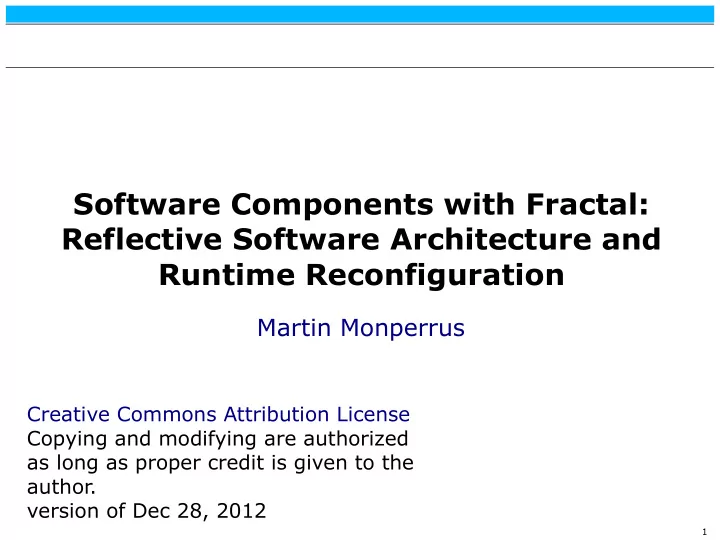

Software Components with Fractal: Reflective Software Architecture and Runtime Reconfiguration Martin Monperrus Creative Commons Attribution License Copying and modifying are authorized as long as proper credit is given to the author. version of Dec 28, 2012 1
[Take-away] Fractal provides you with Automated dependency injection (no setter, constructor) ● Safe assembly ● Safe reconfiguraton ● 2
Sources The fractal component model and its support in java: http://www.cs.colostate.edu/saxs/se/FractalComponent.pdf Fractal Specification: http://fractal.ow2.org/specification/fractal-specification.pdf Fractal API: http://fractal.ow2.org/current/doc/javadoc/fractal/index.html Acknowledgments: Thanks a lot to Lionel Seinturier and Eric Bruneton for helping me in preparing the lecture 3
Where is the architecture? Hidden! No difference between short- lived objects and architectural objects 4
But there is a kind of architecture public class HTTPServer { public static void main (String[] args) { RequestReceiver rr = new RequestReceiver(); RequestAnalyzer ra = new RequestAnalyzer(); RequestDispatcher rd = new RequestDispatcher(); FileRequestHandler frh = new FileRequestHandler(); ErrorRequestHandler erh = new ErrorRequestHandler(); Scheduler s = new MultiThreadScheduler(); Logger l = new BasicLogger(); rr.analyzer= ra; rr.scheduler = s; ra.handleRequest = rd; ra.logger = l; rd.handler.add(frh); rd.handler.add(erh); rr.run(); } } Assembling the application is error-prone Reconfiguring the application at your own risk. 5
"A software architecture of a program or computing system is the structure or structures of the system, which comprise software components, the externally visible properties of those components, and the relationships among them." [Software architecture in practice, Len Bass, Paul Clements, Rick Kazman, 1998] 6
Architecture Description Language An Architecture Description Language is a notation in which architecture models can be expressed. 7
The simplest Fractal assembly ("example.fractal") <definition name="XApp" > <component name="a" definition="XCompA" > <interface name="Capability-client" role="client" signature="java.lang.Runnable" /> <content class="XCompA" /> </component> <component name="b" > <interface name="Capability-server" role="server" signature="java.lang.Runnable" /> <content class="XCompB" /> </component> <binding client="a.Capability-client" server="b.Capability-server" /> </definition> XCompB XCompA Provided Interface= Server Required Interface = Client Binding 8
The simplest Fractal assembly <definition name="XApp" > <component name="a" definition="XCompA" > <interface name="Capability-client" role="client" signature="java.lang.Runnable" /> <content class="XCompA" /> </component> <component name="b" > <interface name="Capability-server" role="server" signature="java.lang.Runnable" /> <content class="XCompB" /> </component> <binding client="a.Capability-client" server="b.Capability-server" /> </definition> public class XCompA public class XCompB implements BindingController implements Runnable { } { private Runnable field; ... } 9
To bind components 4 methods to add, nothing to modify. import org.objectweb.fractal.api.control.BindingController; public class XCompA implements BindingController { private Runnable field; private Logger l; public String[] listFc () { return new String[] { " Capability-client "}; } public Object lookupFc (String itfName) { if (itfName.equals(" Capability-client ")) { return field; } throw new NoSuchInterfaceException(itfName); } public void bindFc (String itfName, Object itfValue) { if (itfName.equals(" Capability-client ")) { field = (Runnable)itfValue; } throw new NoSuchInterfaceException(itfName); } public void unbindFc (String itfName) { if (itfName.equals(" Capability-client ")) { field = null ; } throw new NoSuchInterfaceException(itfName); } ● bindFc/unbindFC are generic getter and setters ● lookupFc and listFC are elements of reflection ● implementation very systematic and easy 10
Runing a Fractal application The command-line way: $ java -cp .... .Dfractal.provider= org.objectweb.fractal.julia.Julia org.objectweb.fractal.adl.Launcher.main -fractal example The programmatic way: public static void main(String[] args) throws Exception { // select the implementation of the component model System. setProperty ("fractal.provider", "org.objectweb.fractal.julia.Julia"); Factory f = FactoryFactory. getFactory (FactoryFactory. FRACTAL_BACKEND ); Component comp = (Component)f.newComponent("example", null ); Fractal. getLifeCycleController (comp).startFc(); ((Runnable)comp.getFcInterface(" Runnable ")).run(); } 11
Fractal Core Insights class A implements I1 { I2 field; } class B implements I2 I1 is a provided interface: we can plug an A into a field ● B is a required interface: field can not be null ● Same as hardware: male (implements)/female (field), interface ● 12
The Fractal Component Model A Fractal component defines: ● a set of interfaces ● a scope (not all components can be bound together, contrary to objects) ● an implementation class A Fractal interface defines: ● a signature ● a role ● provided interface ("role=server") ● required interface ("role=client") ● a cardinality ● singleton (default) ● collection (cardinality="collection") ● a contingency ● mandatory (default) ● optional (contingency="optional") The framework handles the semantics of the assembly 13
Architecture Description Language Advantages: ● Declarative definition of component assemblies ● No compilation required ● Semantic checking of the properties of the assembly: ● e.g. mandatory interfaces ● e.g. scoping rules 14
Element of semantics <!-- abstract component definition --> <definition name="DispatcherType"> <interface name="h" role="client" signature="RequestHandler" cardinality="collection" contingency="optional"/> </definition> <!-- concrete, instanciable component --> <definition name="Dispatcher2" <definition name="Dispatcher1" extends="DispatcherType"> extends="DispatcherType"> <content ? <content class="comanche.Dispatcher2"/> class="comanche.Dispatcher1"/> </definition> </definition> public class Dispatcher2 implements public class Dispatcher1 {} BindingController { } Incorrect: if the component type has Correct a client interface (field to be set), the implementation class must implement BindingController (generic setter) 15
Element of semantics <definition name="DispatcherType"> <interface name="rh" role="server" signature="Capability"/> <interface name="h" role="client" signature="RequestHandler" cardinality="collection" contingency="optional"/> </definition> <definition name="Dispatcher1" <definition name="Dispatcher2" extends="DispatcherType"> extends="DispatcherType"> <content <content ? class="comanche.Dispatcher1"/> class="comanche.Dispatcher2"/> </definition> </definition> public class Dispatcher1 implements public class Dispatcher2 implements BindingController { Capability, BindingController { RequestHandler obj; RequestHandler obj; } Correct Incorrect: the implementation } class must implement all "server" interfaces (Capability is missing) 16
Element of semantics <definition name="ComponentA"> <interface name="rh" role="server" signature="Capability"/> <content class="comanche.ComponentA"/> </definition> <definition name="ComponentB"> <interface name="h" role="client" signature="Capability" cardinality="collection" contingency="optional"/> <content class="comanche.ComponentB"/> </definition> <definition name="Application"> <definition name="Application"> <component name="a" <component name="a" definition=" ComponentA "/> definition=" ComponentA "/> ? <component name="b" <component name="b" definition=" ComponentB "/> definition=" ComponentB "/> <binding client="a.rh" <binding client="b.h" server="b.h"/> server="a.rh"/> </definition> </definition> Incorrect: A binding must Correct complies with client/server specification (a.rh is server not client) 17
Recommend
More recommend